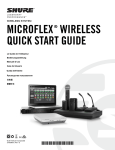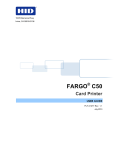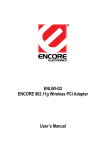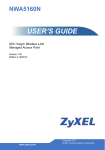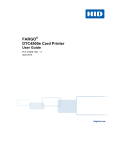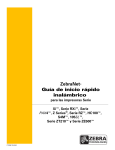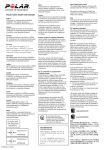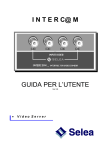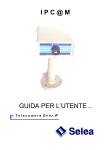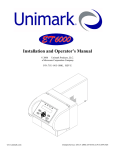Download EnGenius Technologies 802.11b User's Manual
Transcript
IEEE 802.11b Outdoor Wireless Client Bridge User Manual November 03, 2004 Version 1.00 ■ Contents CHAPTER 1. 1.1 1.2 1.3 1.4 1.5 INTRODUCING THE WIRELESS CLIENT BRIDGE ........................................... 1 PRODUCT FEATURES ................................................................................. 1 PACKAGE CONTENTS................................................................................. 1 SYSTEM REQUIREMENTS ........................................................................... 2 INLINE POWER INJECTOR (POE) ................................................................ 2 CHAPTER 2. INSTALLATION AND BASIC CONFIGURATION......... 3 2.1 BEFORE YOU START.................................................................................. 3 2.2 LOCATE THE WIRELESS CLIENT BRIDGE AND INLINE POWER INJECTOR PORTS 4 2.3 PREPARING INSTALLATION ........................................................................ 7 2.4 BASIC CONFIGURATION............................................................................. 9 2.4.1 What you need to know..................................................................... 9 2.4.2 Basic Configuration Steps ................................................................ 9 2.4.3 Login into the Web Interface .......................................................... 10 2.4.4 Set IP Address, Subnet Mask, Default Route IP ............................. 13 2.4.5 Set Wireless Encryption for Wireless Interface .............................. 14 2.4.6 Change Supervisor Account & Password ...................................... 15 2.4.7 Upgrade the Firmware ................................................................... 16 2.4.8 Back-up the Wireless client bridge’s Configuration Files ............. 20 CHAPTER 3. 3.1 3.2 3.3 3.4 NETWORK TOPOLOGIES ............................................... 22 WIRELESS CLIENT BRIDGE-TO-CENTRAL WIRELESS BRIDGE .................. 23 WIRELESS CLIENT ROUTER-TO-CENTRAL WIRELESS BRIDGE ................. 24 WIRELESS CLIENT BRIDGE-TO-CENTRAL WIRELESS ROUTER ................. 25 WIRELESS CLIENT ROUTER-TO-CENTRAL WIRELESS ROUTER ................ 26 CHAPTER 4. Before operating the unit, please read this manual thoroughly, and retain it for future reference. INTRODUCTION .................................................................. 1 NETWORK PARAMETERS.............................................. 28 4.1 IP CONFIGURATION ................................................................................. 28 4.2 CONFIGURE SNMP.................................................................................. 28 4.2.1 Configure Community Pool............................................................ 28 4.2.2 Configure Trap Host Pool.............................................................. 30 4.3 CONFIGURE WIRELESS RELATED PARAMETERS ....................................... 32 4.4 UTILITY ................................................................................................... 35 4.4.1 Software Upgrade........................................................................... 35 4.4.2 Administration ................................................................................ 36 CHAPTER 5. Version 1.02 MONITOR INFORMATION ............................................. 37 i 5.1 5.2 5.3 5.4 SYSTEM INFORMATION ............................................................................ 38 STATISTIC INFORMATION ........................................................................ 39 SITE SURVEY ........................................................................................... 40 WIRELESS LINK INFORMATION ............................................................... 41 CHAPTER 6. 6.1 6.2 SPECIFICATIONS .............................................................. 42 HARDWARE SPECIFICATIONS................................................................... 42 SOFTWARE SPECIFICATIONS .................................................................... 44 CHAPTER 7. DEFAULT SETTINGS ........................................................ 45 7.1 GENERAL CONFIGURATION ..................................................................... 45 7.1.1 System............................................................................................. 45 7.1.2 SNMP ............................................................................................. 45 7.1.3 Wireless LAN.................................................................................. 46 7.2 UTILITY ................................................................................................... 48 7.2.1 Software Upgrade........................................................................... 48 7.2.2 Administration ................................................................................ 48 CHAPTER 8. Chapter 1. Introduction 1.1 Introducing the Wireless client bridge The Wireless client bridge is a fully interoperable with IEEE 802.11b compliant Outdoor Wireless Last-mile product. The Wireless client bridge operates in remote bridge mode, and connects Outdoor Wireless Router Bridge to construct point-to-point as well as point-to-multipoint topologies, for maximum flexibility in configuring building-to-building networks to WISP. 1.2 Product Features 9 9 REGULATORY COMPLIANCE INFORMATION ........ 49 9 9 9 9 9 1.3 Outdoor enclosure in compliance with IP67 RF transmit power 100mW (20dBm) with -85dBm Rx sensitivity @ 11Mbps data rate Embedded 9dBi patch directional antenna Support 24VDC 0.8A Power-over-Ethernet NAT/NAPT and Virtual Server Mapping support MIB-II and Private MIB support MAC address based access control Package Contents The product package contains the following items. 1. 2. 3. 4. 5. 6. 7. Version 1.02 ii Version 1.02 One (1) Wireless client bridge Outdoor Wireless Client Bridge unit One (1) 100~240VAC, 50~60Hz AC/DC adapter with wallmount plug and DC plug power cord One (1) 24VDC, 830mA Inline Power Injector (PoE) Three (3) water protect kit consists of 3 of components One (1) 1.8m grounding wire One (1) User manual CD-disc One (1) wall/mast mounting kit, including one (1) band clamp 1 1.4 System Requirements Chapter 2. Installation and Basic Configuration Installation of the Outdoor Wireless Client Bridge requires the following: 1. 2. 3. 4. 1.5 A Windows-based PC/AT compatible computer or Ethernet data device with an available RJ-45 Ethernet port to run the configuration program or with TCP/IP connection to the Ethernet network. A 10/100Base-T Ethernet RJ-45 Ethernet cable is connected to Ethernet network. A RS-232 consol port cable is connected to PC/AT compatible computer. An AC power outlet (100~240V, 50~60Hz) supplies the power. Inline Power Injector (PoE) The Wireless client bridge is equipped with an Inline Power Injector module. The Inline Power Injector (PoE) delivers both data and power to Wireless client bridge unit via a signal Ethernet cable, and gives the following benefits to improve the performance vs. installation cost ratio. 1. 2. 3. 4. This works great in areas where you may not have power and/or Ethernet easily accessible, like house roof. This also allows you to place the Wireless client bridge unit closer to the antenna, more easily thus reducing signal loss over antenna cabling. Ethernet signal travels well over CAT 5 cable but 2.4GHz signal doesn't do as well over antenna cabling. Ethernet cabling is much cheaper than Antenna cabling. This chapter describes the procedures of installing the Wireless client bridge. 2.1 Before You Start After unpacking the system, make sure the following items are present and in good condition. 1. 2. 3. 4. 5. 6. 7. 1 5 Version 1.02 2 Version 1.02 Wireless client bridge Outdoor Wireless Client Bridge unit AC/DC adapter 100~240VAC, 50~60Hz with wall-mount plug and DC plug power cord Inline Power Injector (PoE) 24VDC, 830mA Water protect kit consists of three of components Grounding wire 1.8m User manual CD-disc Wall/mast mounting kit, including one (1) band clamp 3 2 6 4 7 3 9 2.2 Locate the Wireless client bridge and Inline Power Injector Ports 9 9 Interface on the Wireless client bridge Unit 9 Ethernet Port 1 for connecting the RJ-45 CAT-5 Ethernet cable. 9 RS-232 Console Port 2 for connecting the 1.8m RS-232 null modem console cable. 9 Data Input Port 3 for connecting cross-over Ethernet Cable to PC or straight Ethernet cable to Hub Switch Router. 110~240VAC, 50~60Hz AC/DC power adapter DC Input Port 4 Power & Data Output Port 5 for connecting the 30m RJ-45 CAT-5 Ethernet Cable. Grounding Port 6. NOTE: The cross-over or straight type Ethernet cable is not provided in Wireless client bridge shipping package as an accessory. User can find one from computer store in accordance with the length required for indoor deployment. NOTE: The RJ-45 Ethernet cable is not provided in Wireless client bridge shipping package as an accessory. User can find one from computer store in accordance with the length required for outdoor deployment. NOTE: How to make up Water protect kit 1 2 PS:1.Red line is RJ-45 cable 2.Use dryer blew Ardent shrink casing pipe Before After 5 3 4 6 Mount Wireless client bridge on A Wall/Pole The Wireless client bridge can be mounted on the wall, you can use the Wall Mount kit to mount the Wireless client bridge as shown in Figure 2.2.1. Interface on the Inline Power Injector Version 1.02 4 Version 1.02 5 2.3 Preparing Installation Before installing Wireless client bridge for the outdoor application in a hardto-reach location, we recommend to configure and test all the devices first. For configuring the Wireless client bridge, please follow the quick steps below to power up the Wireless client bridge. Step 1: Console Port Connection Figure 2.2.1 Step 4 You can also mount the Wireless client bridge to the mast as shown in Figure 2.2.2. Step 5 Step 2 Step 3 Step 1 Attach the 1.8m RS-232 null modem console cable to the Console Port on the Wireless client bridge unit (refer to page 4), and the other end (DB9 female type) to a terminal or a PC running a terminal emulation program. Step 2 Plug the DC plug of the AC/DC power adapter into the DC Input Port of Inline Power Injector and the wall-mount plug into a power outlet or power strip (refer to page 4). The Power LED on the Inline Power Injector will light up. Figure 2.2.2 Step 3 Run the cross-over type uplink Ethernet cable from Data Input Port (refer topage 4) to the Ethernet port on a PC Version 1.02 6 Version 1.02 7 NOTE: This connection is required for setting up initial configuration information. After configuration is completed, the RS-232 null modem console cable shall be removed, and run a cross-over Ethernet cable from Data Input Port to PC, or a straight Ethernet cable to LAN connection, e.g. Hub. 2.4 Basic Configuration 2.4.1 What you need to know Step 5 Attach one straight Ethernet cable to the Power & Data Output Port on the Inline Power Injector(refer to page 5). The Wireless client bridge can be configured into two operation roles, including Wireless Client Bridge and Wireless Client Router. Step 6 Plug the other end of the straight Ethernet cable to the Ethernet Port (refer to page 5) on the Wireless client bridge. The Wireless client bridge is shipped with default configuration to function as a client bridge between an Ethernet and Wireless network by attaching Wireless client bridge to the wired LAN simply. If user would configure Wireless client bridge, please refer to the following procedures. When the Wireless client bridge receives power over the Ethernet cable, the Wireless client bridge will start its boot sequence and the Active LED on the Inline Power Injector will light up. 2.4.2 Basic Configuration Steps You can configure the Wireless client bridge via HTML browser, such as Microsoft Internet Explorer or Netscape Navigator from a remote host or PC. This section describes a five-step configuration procedure to setup Wireless client bridge workable upon your topology requirement. Step 1 Select an operation mode for Wireless client bridge on the web page “/General Config/System/”, and click FINISH to refresh this page. Step 2 Modify the factory-default parameters on the web page “/General Config/System/”, and click FINISH to save the changes. Step 3 Modify the factory-default parameters on the web page “/General Config/Wireless/”, and click FINISH to save the changes. Step 4 (Optional) Modify other parameters on the web page “/General Config/”, and click FINISH to save the changes. Step 5 Move to page “/Utility/Administration/”, select the Save then Restart and then click FINISH to take effect on the previous configuration changes. Version 1.02 8 Version 1.02 9 Step 4 Reboot Wireless client bridge. 2.4.3 Login into the Web Interface The Wireless client bridge supports access to the configuration system through the use of an HTTP Interface. Step 5 When the Wireless client bridge is powered up, the “Current Network Status” will be displayed as shown below. Web Configuration Before configuring Wireless client bridge, user needs to know the IP Address assigned to the unit. When shipped from the factory, the IP Address 192.168.5.99 was assigned to the Wireless client bridge by default. To start a web connection, use http://192.168.2.1 Identify the IP Address assigned to the unit However, user may change the IP Address later and cannot connect the unit by using the default IP Address. In this case, it is a must to identify the Wireless client bridge current IP Address before configuring. To identify the IP Address, user can use the serial port (refer to page 4) to gain access of the current network status. To start a Serial Port connection by following the steps below. Step 1 Attach the RS-232 null modem console cable (refer to page 4 and page 6) to the RS-232 Console Port on Wireless client bridge. Connect the other end to a terminal or a PC running a terminal emulation program. Step 2 Set the terminal to 115200 baud rate, None Parity, 8 data bits, 1 Stop bit, and ANSI compatible. Step 3 Run a terminal emulation program on PC, such as Hyper Terminal, and set the following connection properties. Web Access Procedures Once you identify the IP Address assigned to Wireless client bridge, use web browser to configure Wireless client bridge through the HTTP Interface. The following procedure explains how to configure each item. Step 1 Open your browser and enter the IP Address Step 2 Press <ENTER> key and the Wireless client bridge Login screen appears as shown below. Step 3.1 Click the Start icon > Program > Accessories > Communication > Terminal. Step 3.2 Create a new connection file, and select a Com Port <COM1, COM2, etc., depending on PC> with 115200bps / 8-bits / 1-stop. Step 3.3 Click the properties icon in the Tool Bar > setting > select Emulation terminal VT100 > ok. Version 1.02 10 Version 1.02 11 ● ● Step 3 Enter “root” in the User Name and the Password fields, and click OK to enter the web configuration user interface screen as shown below. Site Survey Wireless Link Info ▽ Utility ● ● Software Upgrade Administration Move through the tree by clicking on an icon to expand or collapse the tree. The nodes on the tree represent web pages that allow viewing and modifying the parameters. 2.4.4 Set IP Address, Subnet Mask, Default Route IP Web Configuration Structure The web configuration user interface is grouped into a tree structure, and contains the following settings or information. ▽ General Configuration ● System ● TCP/IP - SNMP ● Wireless Host Information The Host Name is not an essential setting, but it helps to identify the device in network. Use this setting to assign a name to the device. ▽ Running Status ● System Info ● Statistic Info Version 1.02 12 Version 1.02 13 IP Use MAC Addr. You can choice Enable or Disable. If you choice Enable , it will set IP = 10.X.X.X that used to last 3 MAC Address ID. For example : MAC Addr = 00:47:55:43:43:49 => IP = 10.67.67.73(43hex=67decimal) If you choice Disable you need setting Bridge IP Address Information. 2.4.6 Change Supervisor Account & Password Enter the Utility > Administration page. The figure below shows the Utility/ Administration page. Bridge IP Address Use this setting to assign or change the Wireless client bridge IP address. Bridge Subnet Mask Enter an IP subnet mask to identify the sub network so the IP address can be recognized on the LAN. Default Gateway IP Address Enter the default Gateway IP Address, and click FINISH at the bottom of this page to complete the modification of this page. 2.4.5 Set Wireless Encryption for Wireless Interface The Wireless client bridge supports 64-bit and 128-bit WEP encryption. For 64-bit WEP encryption, an encryption key is 10 hexadecimal characters (0-9 and A-F) or 5 ASCII characters. For 128-bit WEP encryption, an encryption key is 26 hexadecimal characters or 13 ASCII characters. Supervisor Account Change the supervisor’s user name and password in the Supervisor Account field, and click FINISH to take effect on the previous configuration changes. Modify the WEP encryption parameters on the web page “/General Config/Woreless/”. Enter 1~15 characters into the WEP Key field, and click KeyGen to generate the WEP64 or WEP128 key patterns. Apply the New Settings Step 1 Enter the Utility > Administration page, select the Save then Restart to apply the new configuration settings. Step 2 Click FINISH to take effect on the previous configuration changes. Hint: It takes about 10 seconds, to complete the restart process. Version 1.02 14 Version 1.02 15 2.4.7 Upgrade the Firmware Setup your TFTP Server The Trivial File Transfer Protocol (TFTP) Server allows you to transfer files across a network. You can download the firmware files for Wireless client bridge upgrades. After the TFTP Server is installed, make sure you have the proper TFTP Server IP address, the proper Wireless client bridge firmware files, and the TFTP Server is operational. Update the Firmware using the TFTP method Step 1 Enter the Utility > Software Upgrade page as shown in the figure below, and can use TFTP to upgrade Wireless client bridge. Here, user must specify the TFTP server IP and select which file you want to upgrade it (Program image, Web image), then click OK button to start the TFTP upgrade process. Step 2 If the upgrade process is success, the Wireless client bridge will apply the new settings and start rebooting right away. Hint: You must set up a TFTP Server and this server must contain the latest new image files. Upgrade the Firmware using RS-232 console Please refer to Provision 2.4.3 that introduces how to use RS-232 console port. Identify the IP Address assigned to the unit. Step 1 If the connection is normal, when the Wireless client bridge is powered up, the “Current Network Status” will be displayed as Version 1.02 16 Version 1.02 17 shown below. Step 2 Press <Esc> keystroke to reboot the Wireless client bridge. Press <x> key during the boot process, and it will display prompt character NetARM> as the figure shown in the next page. Step 3 Press “h” keystroke, it will display related commands as the figure shown below. Step 4 Select “F -- upgrade Flash memory” and it will display upgrade items for selection as the figure shown below. Step 5 Select “3: SOHO” and select “4: WEBIMG” to update the firmware files one by one. Step 6 While the window starts to display “C” character continuously, click Transfer and select the new firmware files <soho.bin> file, press “OK” to start to transfer file to Wireless client bridge. Step 7 Select “4” to upgrade WEBIMG file. The procedures are the same with upgrading SOHO file (go back to step 5), but should select <pfs.img> file correctly for WEBIMG file upgrade. Step 8 After the upgrade completes, remember to press “R” keystroke to reboot the system. Note: The default transfer protocol is using “Xmodem”, so please make sure you select correct protocol to download/upload files when you try to upgrade the Wireless client bridge’s firmware files. Version 1.02 18 Version 1.02 19 2.4.8 Back-up the Wireless client bridge’s Configuration Files After configuring Wireless client bridge, user can back-up the configuration files. User can upload the latest back-up files and recover the Wireless client bridge configuration to the settings specified in the back-up files. Downloading Configuration Files Just being the same with firmware upgrade procedures. After the prompt character NetARM> is displayed, select “S – Save image to file”, and then select “6: CONFIG” to back-up the Wireless client bridge configuration as the figure shown below. The back-up file will be saved as <CONFIG.IMG> file. Note: Remember to press “R” to reboot the system after you upload the configuration file to the Wireless client bridge Uploading Configuration Files To upload an configuration file to Wireless client bridge, user should select “F -- upgrade Flash memory” and then select “6: CONFIG”. While the window starts to display “C” character continuously, click Transfer and select the preferred <CONFIG.IMG>, then press OK to start transferring file to Wireless client bridge. Version 1.02 20 Version 1.02 21 Chapter 3. Network Topologies 3.1 Wireless Client Bridge-to-Central Wireless Bridge This chapter describes several main types of installations implemented by using the Outdoor Wireless System commonly. This is by no means intended to be an exhaustive list of all possible configurations, but rather shows examples of some of the more common implementations. The Wireless client bridge can only be configured into Wireless Client Router/Bridge to accomplish the broadband wireless point-to-point, pointto-multipoint systems with Central Bridge as the figure shown below. *1 Step 1 Set the Central Outdoor Unit (hereinafter, “COU”) to perform a bridge (bridge IP address: 192.168.2.1). Step 2 Set Wireless parameters on COU: Channel (1) and SSID (wireless) The Wireless client bridge performs in either router or bridge mode. In a Point-to-Multipoint topology, all communication between network systems is done through a centralized agent. Among the Outdoor Wireless Router/Bridge products, the centralized agent is Central Router or Central Bridge and the individual network notes may be Wireless Client Router or Bridge . To show the available Point-to-Multipoint topologies, the following examples are provided. 1. Wireless Client Bridge-to-Central Wireless Bridge 2. Wireless Client Router-to-Central Wireless Bridge 3. Wireless Client Bridge-to-Central Wireless Router 4. Wireless Client Router-to-Central Wireless Router Version 1.02 *2 Step 3 Set the Remote Outdoor Unit (hereinafter, “ROU”) to perform a bridge (bridge IP address: 192.168.2.2). Step 4 Set Wireless parameters on ROU: Channel (1) and SSID (wireless), and these parameters must be the same with COU. Step 5 Left side subnet is transparent to the right side. Step 6 DHCP server assign IP address to PC1 and PC2 Remarks: *1 COU refers to Outdoor Wireless Router Bridge *2 Both and Wireless client bridge could function the role of ROU 22 Version 1.02 23 3.2 Wireless Client Router-to-Central Wireless Bridge 3.3 Wireless Client Bridge-to-Central Wireless Router Step 1 Set the COU to perform a bridge (bridge IP address: 192.168.2.1). Step 1 Set the COU to perform a Wireless Router (Wireless Interface IP: 192.168.1.1, Ethernet Interface IP: 192.168.2.1). It is a must to enable NAT on Ethernet interface (default route: 192.168.2.254). Step 2 Set Wireless parameters on COU: Channel (1) and SSID (wireless). Step 2 Set Wireless parameters on COU: Channel (1) and SSID (wireless) Step 3 Set the ROU to perform a Router (Wireless Interface IP: 192.168.2.2, Ethernet Interface IP: 192.168.10.1). It is a must to enable NAT on Wireless Interface (default route is 192.168.2.254). Step 3 Set the DHCP server service on the COU and apply it on Wireless Interface. Step 4 Set the ROU to perform a Bridge (Bridge Interface IP: 192.168.1.2). Step 4 Set Wireless parameters on ROU: Channel (1) and SSID (wireless), these parameters must same with COU. Step 5 Set the DHCP server service on the ROU and apply it on Ethernet Interface. Step 5 Set Wireless parameters on ROU: Channel (1) and SSID (wireless), and these parameters must be the same with the COU. Step 6 The COU assigns IP addresses to PC1 and PC2. Step 6 The ROU assigns IP addresses to PC1 and PC2 Step 7 The operator can also disable NAT behavior on COU to make the two subnets transparent. Version 1.02 24 Version 1.02 25 The operator can also disable NAT behavior on COU and enable NAT behavior on ROU (enable NAT on Wireless Interface). In this case, any outgoing packets will transfer to 192.168.1.2. 3.4 Wireless Client Router-to-Central Wireless Router The operator can also enable NAT behavior on COU (enable NAT on Ethernet interface) and enable NAT behavior on ROU (enable NAT on Wireless Interface). Step 1 Set the COU to perform a Wireless Router (Wireless Interface IP: 192.168.1.1, Ethernet Interface IP: 192.168.2.1, default route: 192.168.2.254). Step 2 Set Wireless parameters on COU: Channel (1) and SSID (wireless). Step 3 Set the ROU to perform a Wireless Router (Wireless Interface IP: 192.168.1.2, Ethernet Interface IP: 192.168.10.1, default route: 192.168.1.1). Step 4 Set Wireless parameters on ROU: Channel (1) and SSID (wireless), and these parameters must be the same with COU. Step 5 Set the DHCP server service on the ROU and apply it on Ethernet Interface. Step 6 The ROU assigns IP addresses to PC1 and PC2. Version 1.02 26 Version 1.02 27 Chapter 4. Network Parameters 4.1 IP Configuration Wireless Client Bridge Step 1 Enter the IP Address manually into the Bridge IP Address field. Step 2 Use Bridge IP Address setting to assign or change the bridge’s IP address. Step 3 Click FINISH at the bottom of this page to complete the modification of IP address. 4.2 Configure SNMP Select the “/General Config/ TCP/IP/SNMP”, and the SNMP screen appears. The figure below shows the current SNMP community pool and trap host pool. 2. Specify the Validity, Access Right and Community field. 9 Validity. Select Enable or Disable to control this community. 4.2.1 Configure Community Pool 9 Access Right. Select a command from the pull down menu The SNMP Community Pool has five entries. 1. Version 1.02 for this field. 9 Community. Enter the password related the Access Right To modify the entry, click the select button beside the entry index number and click Modify. The configuration page appears as the figure shown below. in this field. 28 3. Click OK to refresh the current community pool. 4. To modify another community entry to the current community pool, repeat step 1 through step 3. 5. When you have modified all the entries preferred, click FINISH. Version 1.02 29 4.2.2 Configure Trap Host Pool 3. Click OK to refresh the current trap host pool. 4. To modify another trap host entry to the current trap host pool, repeat step 1 through step 3. 5. When you have modified all the entries preferred, click FINISH. The Trap Host Pool has five entries. 1. To modify a entry, click the select button beside the entry index number and click Modify . The configuration page appears as following figure. 2. Specify the Version, IP Address and Community field. 9 Version. Select Disable, Version 1 or Version 2 to control this trap host. 9 IP Address. Enter the Trap Host IP Address. 9 Community. Enter the password in this field. Version 1.02 30 Version 1.02 31 4.3 Step 4 Click FINISH at the bottom of this page to complete the modification. Configure Wireless related parameters The following gives more info about the parameters set in the Wireless LAN information page to users. Step 1 Select “/General Config/Wireless” and the Wireless LAN information page appears as the figure shown below. rts Threshold The setting determines the packet size, ranging from 0 to 2339 bytes, at which the bridge issues a request to send (RTS) before sending the packet. A low RTS Threshold setting can be useful in areas where many client devices are associating with the access point, or in areas where the clients are far apart and can detect only the bridge and not each other. frag Threshold The setting determines the size, ranging from 256 to 2338 bytes, at which packets are fragmented (sent as several pieces instead of as one block). Use a low setting in areas where communication is poor or where there is a great deal of radio interference. SSID The Service Set ID (SSID) can be any alphanumeric, case-sensitive entry from 2 to 32 characters long. This string functions as a password to join the radio network. Station Name Enter any alphanumeric, case-sensitive entry. Step 2 In the Wireless LAN information page, set the following parameters suitable for your radio network. 9 9 9 9 rts Threshold (default parameter: 60) frag Threshold (default parameter: 2346) SSID (default parameter: wireless) Station Name (default parameter: ap) WEP Key Enter 1~15 characters for 64 and 128 bits WEP KEY encryption, and then click KeyGen to generate the WEP64 & WEP128 key patterns automatically. WEP User can Disable or enable 64/128 bit WEP services here. Default Key Select an encryption key from the pull down menu. Step 3 Click radio button to disable WEP or enable 64/128 bit WEP services (default parameter: disable). If WEP is enabled, input corresponded Default Key index and WEP Key and then click KeyGen to generate the WEP64 & WEP128 key patterns. Version 1.02 WEP64 Key1~4 & WEP128 Key1~4 The keys in these fields can be generated automatically by KeyGen function. For 40-bit encryption, enter 10 hexadecimal digits; for 128-bit encryption, enter 26 hexadecimal digits. Hexadecimal digits include the 32 Version 1.02 33 numbers 0 through 9 and the letters A through F. The 40-bit WEP keys can contain any combination of 10 of these characters; the 128-bit WEP keys can contain any combination of 26 of these characters. The letters are not case-sensitive. 4.4 Utility 4.4.1 Software Upgrade Step 1 Click Utility, select Software Upgrade page as the figure shown below, and then use TFTP to upgrade AP. In the Utility – Software Upgrade page, user must specify the TFTP server IP and select by which file to upgrade (Program image, Web image), then click OK button to start the TFTP upgrade process. Step 2 If the upgrade process is success, the AP will apply the new settings and start rebooting right away. Hint: You must set up a TFTP server and this server must contain one latest new image. Version 1.02 34 Version 1.02 35 4.4.2 Administration Chapter 5. Monitor Information Step 1 Click Utility, Administration. The following figure shows the Utility – Administration page. User can find the system running status and other information on this window. Click the Running Status link on the left window, use can choose which function that he wants to monitor. General System Information The following information can be found in this block. 9 9 9 9 9 9 9 Product Model Host Name Software Version Build (Built by) Boot Code Version Web Version System Uptime General System Status The following information can be found in this block. 9 9 9 9 Operation Mode Bridge IP Address Bridge Subnet Wireless SSID Services Information This block shows whether the following services are enabled or disabled. 9 Supervisor Account. Change the supervisor’s user name & password in the Supervisor Account field, and Click FINISH to take effect on the previous configuration changes. 9 Apply the New Settings. Click Utility, Administration, select the Save then Restart to apply the new configuration settings. 9 9 9 9 NAPT SNMP MAC Filter WEP encryption. Step 2 Click FINISH to take effect on the previous configuration changes. Hint: It takes about 10 seconds, to complete the restart process. Version 1.02 36 Version 1.02 37 5.1 System Information 5.2 Statistic Information By selecting “Running Status/System Info”, enter the System Information page as the figure shown below. By selecting “Running Status/Statistic Info”, the figure below shows the Statistic of Interface page. In this page, user can find the system information and most of the running parameters. In this page, user can find the packet statistic of each interface, Wireless and Ethernet. This statistic table includes the following information. 9 9 9 9 Version 1.02 38 Version 1.02 In Packets Out Packets In Bytes Out Bytes. 39 5.3 Site Survey 5.4 By selecting “Running Status/Site Survey”, enter the Site Survey page as the figure shown below Wireless Link Information This item only displayed on ROU mode. By selecting “Running Status/Wireless Link Info”, the figure below shows the Radio Link Information page. In this page, user can click REFRESH find the AP near Wireless client bridge. This statistic table includes the following information. In this page, user can find the following information about the radio link. 9 9 9 9 9 9 Version 1.02 SSID BSSID Channel Type Encrypt Signal 9 9 9 9 9 9 9 40 Version 1.02 Link Status Current SSID SNR( C / I ) RSL Noise Level Current Channel Current Tx Rate 41 Operation Channels Chapter 6. Specifications 6.1 Hardware Specifications General Radio Data Rate Client Interface Range (Open environment) Regulatory & Safety Certifications Compatibility Power Supply (AC/DC Power Adaptor) 11, 5.5, 2 and 1 Mbps, Auto Fall-Back 10/100Base-T Ethernet 300m @ 11.0Mbps 400m @ 05.5Mbps 500m @ 02.0Mbps 800m @ 01.0Mbps FCC Part 15 EN 300 328-1 EN 300 328-2 EN 301 489-1 EN 301 489-17 EN 60950 IP67 DGT Fully interoperable with IEEE802.11b compliant products Input: 100~240V, 50~60Hz Output: 24V, 830mA Antenna Sensitivity @ FER=0.08 Environmental Temperature Range Humidity (non-condensing) Operating: 0 to 55℃ Storage: -20 to 75℃ 5% to 95% typical Physical Specifications Dimensions Weight 138.7mm x 104.0mm x 38.0mm 500g Network Information Network Architecture Access Protocol Roaming Security Transmit Power DBPSK (1Mbps) North America:11 Japan:14 Europe:13 Spain:2 France:4 10dBm (ETSI) 19dBm (FCC) External 5dBi dipole antenna, or Embedded 9dBi patch antenna 11.0 Mbps < -85dBm 05.5 Mbps < -88dBm 02.0 Mbps < -91dBm 01.0 Mbps < -93dBm Infrastructure (with Wireless client bridge) CSMA/CA IEEE802.11b compliant 64-/128-bit data encryption Radio Specifications Frequency Band Radio Type Modulation Version 1.02 2.4 – 2.484 GHz Direct Sequence Spread Spectrum (DSSS) CCK (11, 5.5Mbps) DQPSK (2Mbps) 42 Version 1.02 43 6.2 Software Specifications Protocol Security Management Firmware upgrade Chapter 7. Default Settings TCP/IP DHCP Client 802.1d Transparent Bridging 64-/128-bit WEP encryption MAC address based access control Web-based Manager Console (RS-232) configuration SNMP v1 SNMP MIB-II Private MIB TFTP (Trivial FTP) Xmodem, 1K Xmodem Zmodem 7.1 General Configuration 7.1.1 System Parameter Host Name Description Host name for the RB IP Use MAC Addr. You can choice IP produced method . Disable Bridge IP Address Bridge Subnet Mask For Wireless Client Bridge with Operation Mode 192.168.2.1 255.255.255.0 IP address of the gateway for default route when TCP/IP filtering 192.168.2.254 Default Address Gateway IP Default Value ISP 7.1.2 SNMP 7.1.2.1 Table of SNMP Community Pool Parameter Index 1 Index 2 Index 3 Index 4 Index 5 Index 1 Index 2 Index 3 Index 4 Index 5 Index 1 Index 2 Index 3 Index 4 Index 5 Version 1.02 44 Version 1.02 Validity Access Right Description Default Value Enable or disable the function of the corresponding community index Enable Enable Disable Disable Disable Read Write ------public private ------- Select the access right (Deny/Read/Write/Create) for SNMP Manager Specify the type of community (public or private) for SNMP Community Manager 45 7.1.2.2 Table of SNMP Trap Community Host Pool Parameter Index 1 Index 2 Index 3 Version Index 4 Index 5 Description Select or disable the SNMP Version Version 1: MIB1 Version 2: MIB2 Index 1 Index 2 Index 3 Index 4 Index 5 Specify the IP address of the SNMP Manager for SNMP Trap IP Address Report Index 1 Index 2 Index 3 Index 4 Index 5 Specify the type of community (public or private) for SNMP Community Manager Default Value Version1 Version2 ------192.168.2.100 192.168.2.100 ------public public ------- Key Panel When you use WEP to communicate with the other wireless clients, all the wireless devices in this network must have the same encryption key or pass phrase. Note: each key must consist of hex digits, it means that only digit 0 -9 and letters A-F are valid entries. If entered incorrectly, program will not write keys to a driver. 7.1.3 Wireless LAN Parameter RTS Threshold Fragmentation Threshold SSID Station Name WEP Key WEP Default Key Version 1.02 Description Set RTS (Request To Send) threshold value Set fragmentation threshold value Wireless LAN service area identifier of the RB (case sensitive) Show the name of the AP Push the “KeyGen” button to generate the WEP key patterns automatically 1. WEP128 2. WEP64 3. Disable Select a WEP key to encrypt each frame transmitted from the radio using one the of the 4 Keys from the Key Panel Default Value 60 2346 wireless ap wepkey Disable 1 46 Version 1.02 47 7.2 Utility Chapter 8. Regulatory Compliance Information 7.2.1 Software Upgrade Parameter TFTP Server IP Address Upgrade Filename Description Specify the IP address of the TFTP server to upgrade the firmware of the RB Program Image Web Image Radio Frequency Interference Requirements This device complies with Part 15 of FCC Rules and Canada RSS-210. Operation is subject to the following conditions: This device may not cause harmful interference. This device must accept any interference received, including interference that may cause undesired operation. Default Value 192.168.2.100 SUSW.Bin SUFS.Img Radiation Exposure Statement This equipment complies with FCC radiation exposure limits set forth for an uncontrolled environment. This equipment should be installed and operated with minimum distance 20 cm between the radiator & your body. 7.2.2 Administration Parameter Supervisor ID Supervisor Password Password Confirm Description Supervisor’s identity code Supervisor’s password Confirm the password again Default Value root root root This transmitter must not be co-located or operating in conjunction with any other antenna of transmitter. Interference Statement This equipment has been tested and found to comply with the limits for a Class C digital device pursuant to Part 15 of the FCC Rules and Regulation. These limits are designed to provide reasonable protection against harmful interference in a residential installation. This equipment generates, uses, and can radiate radio frequency energy and, if not installed and used in accordance with the instruction manual, may cause harmful interference to nearby TV’s, VCR’s, radio, computers, or other electronic devices. To minimize or prevent such interference, this equipment should not be placed or operated near these devices. If interference is experienced, moving the equipment away from them will often reduce or eliminate the interference. However, there is no guarantee that interference will not occur in a particular installation. If the equipment does cause harmful interference to radio or television reception, which can be determined by turning the equipment off and on, the user is encouraged to try to correct the interference by one or more of the following measures: Re-orient or relocate the receiving antenna. Increase the separation between the equipment and receiver. Connect the equipment into an outlet on a circuit different from that which the receiver is connected. Consult the dealer or an experienced radio/TV technician for help. Version 1.02 48 Version 1.02 49 European Community – CE Notice Marking by the symbol: Professional Installation Per the recommendation of the FCC, the installation of high gain directional antenna to the system, which are intended to operated solely as a point-topoint system and whose total power exceeds +30dBm EIRP, require professional installation. It is the responsibility of the installer and the end user that the high power systems are operated strictly as a point-to-point system. Systems operating as a point-to-multipoint system or use non directional antennas cannot exceed +30dBm EIRP power requirement under any circumstances and do not require professional installation. Indicates compliance with the essential requirements of Directive 1999/5/EC. Such marking is indicative that this equipment meets or exceeds the following technical standards: Marking by the symbol: Indicates compliance with the essential requirements of R&TTE Directive 99/5/EC, and the product is permitted to be used in the following EC countries, including Germany, UK, The Netherlands, Belgium, Norway, Sweden, Denmark, Finland, France, Italy, Spain, Austria, Iceland, Ireland, Portugal, Switzerland, Greece and Luxembourg. Information to User The user manual or instruction manual for an intentional or unintentional radiator shall caution the user that changes or modifications not expressly approved by the party responsible for compliance could void the user’s authority to operate the equipment. Declaration of Conformity Declares that the product: Date:November 18, 2003 Model Number:Wireless client bridge Equipment Type:Wireless Access Bridge Made in Taiwan 9 9 9 9 EN 300 328-2 EN 301 489-1 EN 301 489-17 EN 60950 中華民國交通部電信總局低功率射頻電機型式認證 型式認證標籤式樣: Complies with Part 15 Class C of the FCC rules. Operation is subject to the following two conditions: (1) this device may not cause harmful interference, and (2) this device must accept any interference received, including interference that may cause undesired operation. 依據交通部電信總局『低功率輻射性電機管理辦法』第十四條規定,經型式 認證合格之低功率射頻電機,非經許可,公司、商號或使用者均不得擅自變 更頻率、加大功率或變更原設計之特性及功能。 依據交通部電信總局『低功率輻射性電機管理辦法』第十七條規定,低功率 射頻電機之使用不得影響飛航安全及干擾合法通信;經發現有干擾現象時, 應立即停用,並改善至無干擾時方得繼續使用。前項合法通信,指依電信法 規定作業之無線電信。低功率射頻電機須忍受合法通信或工業、科學及醫療 用電波輻射性電機設備之干擾。 Version 1.02 50 Version 1.02 51



























